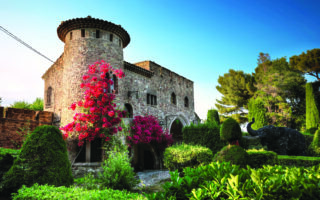A penchant for Manche
So close but so enchantingly different, Manche offers a seductive lifestyle right on your doorstep, as Gillian Thornton discovers
Ever since William the Conqueror set foot on English soil, the history of the British Isles has been inextricably linked with Normandy. Almost 950 years on, the momentum has been reversed as the five departments within the regions of Upper and Lower Normandy welcome waves of British visitors every year.
Of Normandy’s three maritime departments, the long finger of Manche takes its name from France’s moniker for the Channel, and boasts the longest coastline running along its western and northern boundaries, as well as the eastern shore from Barfleur to the Baie des Veys. To the south, the lush green interiors blend seamlessly with Calvados and Orne, giving way to Brittany and Pays-de-la-Loire.
Closest to England at the head of the Cotentin peninsula, stands the historic port of Cherbourg. A departure point for great transatlantic cruise liners such as Titanic and Queen Mary, it was of huge strategic importance to both sides during World War II. The Cité de la Mer’s permanent exhibition to Titanic, opened in 2012 for the centenary, is a favourite visitor attraction, and also outlines the story of Man’s underwater exploration told within the historic museum surroundings of Cherbourg’s art deco gare maritime.
Today, Cherbourg’s proximity helps to make Manche so attractive to British visitors with regular ferry services to Portsmouth and Poole. But there are other attractions too. British visitors are well received in Manche, not just for the legacy of D-Day and the Allied initiative of Operation Overlord, but for their investment in rural properties, helping to safeguard France’s architectural heritage. Base yourself in Manche and nothing is very far away. You can drive from the east to the west coast of the peninsula in little more than an hour, and yet much of the department is deeply rural and unspoilt.
If you like dramatic seascapes and quiet countryside, the area of La Hague west of Cherbourg is a delight. Stop off at Gréville-Hague and you can walk in the foosteps of painter Jean-François Millet, member of the Barbizon School and a forerunner of the Impressionists – a visit to his birthplace in the hamlet of Gruchy sees reproductions of his paintings along the cliff-top paths.
La Hague is dotted with stone mansions such as Château de Nacqueville, some of them open to visitors on summer afternoons, while the Ludiver Planetarium at Tonneville provides an interactive insight into weather patterns and the night sky. But it’s the natural landscape that really packs a punch, such as the pounding waves at Cap de la Hague and the tiny harbour of Port Racine, as well as the high windswept cliffs and quiet sheltered maritime coves.
Head south down the west coast and the road winds through a succession of sandy bays and estuaries overlooking the Îles Anglo-Normandes, better known to Brits as the Channel Islands. Barneville-Carteret is a favourite summer resort with its sandy beaches and family-friendly atmosphere, while Granville offers a historic hilltop town above a busy marina. Don’t miss the chic exhibitions in the pink and white childhood home of Christian Dior on the cliffs above Granville beach.
South of Granville stands not just the most iconic symbol of Manche, but also one of the nation’s most popular visitor attractions, Mont Saint-Michel. The hilltop abbey and ancient houses rise out of the shallow bay in the angle between Normandy and Brittany, and while Bretons hotly dispute the fact, this classified monument historique actually belongs to Manche.
The project to do away with the solid causeway and restore Mont Saint-Michel to its island state has been much publicised, as have the teething problems with access arrangements. However, all now seems to have been ironed out and shuttle buses regularly leave from the mainland car park. Arrive early, late or out of season for the most intimate experience, or better still, book a walk across the bay at low tide with qualified guides for a unique perspective on this most familiar of monuments.
For those who choose the east coast route out of Cherbourg, the road leads first to Barfleur, departure point for William the Conqueror and now classified amongst the elite Plus Beaux Villages de France. Don’t miss the coastal town of St-Vaast-la Hougue and neighbouring Île de Tatihou with its bird reserve and UNESCO-listed Vauban fort.
The coastline then flattens out around Quinéville into the notorious sands known the world over as Utah Beach. American troops landed here on 6 June 1944 – visitors to the Musée du Débarquement overlooking the sands at Sainte-Marie du Mont and the Musée Airborne at Sainte-Mère-Église, will spot the much-photographed dummy hanging by his parachute from the church tower beside the car park – a tribute to one young American who survived by playing dead.
But the Cotentin Peninsula isn’t all about the coast. The interior is largely unspoilt and property is cheaper here, while still within easy reach of the sea. Valognes, just south of Cherbourg, is well worth a stopover for its elegant 18th-century buildings. Pick up the free leaflet of tourist trails and visit the Hôtel de Beaumont to see the inside of the Cotentin’s most sumptuous private mansion. Nearby Bricquebec also boasts an historic monument: a medieval castle with ramparts and keep, roughly circular, surrounded by a road, and incorporating an atmospheric hotel and restaurant.
Agriculture is an important industry, and the countryside around Valognes is typical of the famous Norman bocage landscape: verdant fields grazed by livestock. Dairy cattle predominate but many farmers also raise horses in a region renowned for its animals.
Departmental capital Saint-Lô is home to one of Normandy’s two branches of the national stud, and this year will be hosting events as part of the Alltech FEI World Equestrian Games from 23 August to 7 September. With 60 nations taking part in eight different disciplines, horse-lovers flock to Normandy from across the world, proving again that Manche is no stranger to international tourists.
“We welcome a lot of American visitors who are visiting the D-Day sites, as well as cyclists from countries as far away as Iceland and Australia,” says Anne-Laure Guerche, owner of the Manoir de Beaucron chambres d’hôtes near Utah Beach, known to cyclists as a convenient starting point for one of three trails linking the D-Day beaches with Mont Saint-Michel.
Many cycling companies bring adventurers from south-west England to Normandy and beyond, while other pedal-pushers arrive at Mont Saint-Michel from Paris on the Véloscénie trail. Walkers can follow any one of the many pilgrim routes that radiate out from the sacred site, and the lofty abbey also towers over the GR223, or sentier des douaniers, which runs for 430km around the Manche coast.
Drive – or cycle – south down the peninsula towards Carentan or Coutances and you pass through the Parc Naturel Régional des Marais du Cotentin et du Bessin, a lovely spot to settle down with binoculars in a hide or just to stroll the marshland trails. The exhibitions and films in the Maison du Parc at Saint-Côme-du-Mont provide a fantastic introduction to this protected area, which is an important stopover for migratory birds.
The natural park extends eastward across the departmental border into Calvados, but carry on down through Manche and you reach two of its most interesting tourist towns. Avranches, just inland from the Baie du Mont Saint-Michel, is home to the Scriptorial which houses glorious illuminated manuscripts created by monks from the Abbey. Watch films of contemporary calligraphers, bookbinders and papermakers, and view 200 original manuscripts dating back seven centuries.
Manche’s curiously named Villedieu-les-Poêles, a town which is somewhat eccentrically named after its renowned saucepans, is another charming key attraction. ‘God’s Town of the Cooking Pots’ is one of just a few towns in the area to escape damage during World War II. In the 12th century, Henry I of England, Duke of Normandy, granted the Hospitaller brothers of Saint John of Jerusalem a small hamlet here in the Sienne valley, the first Hospitaller commandery in France. A thriving copper industry grew up and Villedieu-les-Saultchevreuil gradually became known as Villedieu-les-Poêles after the items it produced.
Today, the lively town centre is packed with small shops, restaurants and specialist outlets selling copper and other metalware, but it’s still possible to see the narrow courtyards, which once housed dozens of workers’ families. There’s a choice of museums too, including the bell foundry, one of just two in France, which makes around 100 bells a year, one-fifth of them for overseas clients.
The department’s deep south is the area least known to holidaymakers; frequently overlooked as motorists fly past on the main road between Caen and Dinan/Saint-Malo. Quiet, agricultural and low key, it’s particularly beautiful in spring when the fruit trees are in blossom and mares graze the fruit orchards with foals at foot.
This area is home to Mortain, a small town that today lies at the very western tip of the Parc Naturel Régional de Normandie-Maine, but in Norman times was the seat of Count Robert de Mortain, half-brother to William the Conqueror. The 11th-century Église de la Collégiale and the 12th-century Abbaye Blanche are both worth a look, but most people come to walk beside the Petite Cascade in the town centre and the Grande Cascade higher up, where the water spills over a 20-metre granite cliff. From Saint Michael’s Chapel, a lofty 323 metres above sea level, the unmistakeable outline of Mont Saint-Michel is clearly visible on the horizon.
No tour of this picturesque Normandy department can be complete without mention of Barenton, in the south-east corner of the department where the air was heavy with the scent of ripening apples and pears as summer turned to autumn. Stroll the green pathways through the orchards at the Maison de la Pomme et de la Poire, and find out about the traditional cider and perry industry, before sampling a glass or two: crisp apple juice, fruity cider, or the delicious sparkling poiré or perry. The perfect slow-food accompaniment to any delicious Manche meal! LF
[Fact file]
Tourist Information
www.manche-tourisme.com
Where to Stay
La Régence
42 Quai Caligny
50100 Cherbourg
Tel: 00 33 (0)2 33 43 05 16
www.laregence.com
Hôtel des Isles
9 Boulevard Maritime
50270 Barneville-Carteret
Tel: 00 33 (0)2 33 04 90 76
www.hoteldesisles.com
Le Manoir de Beaucron
1 Rue de l’Église
50480 Brucheville
Tel: 00 33 (0)2 33 42 40 25
www.manoirdebeaucron.com
Le Manoir de Clérisson
9 Route de Clérisson
50150 Sourdeval
Tel: 00 33 (0)2 33 59 64 57
www.manoirdeclerisson.e-monsite.com
Where to Eat
Auberge Normande
11C Boulevard de Verdun
50500 Carentan
Tel: 00 33 (0)2 33 42 28 28
www.aubergenormande.com
Le Moulin de Jean
La Lande
50670 Cuves
Tel: 00 33 (0)2 33 48 39 29
www.lemoulindejean.com
Share to: Facebook Twitter LinkedIn Email


